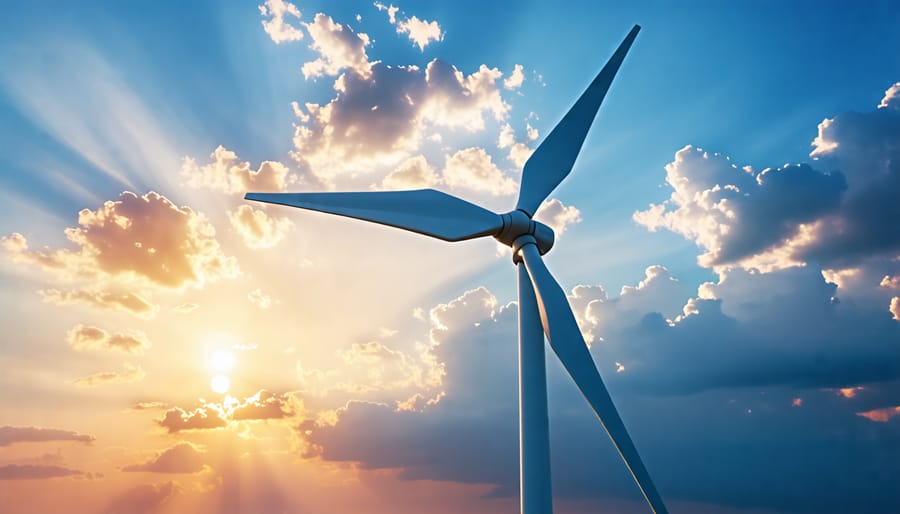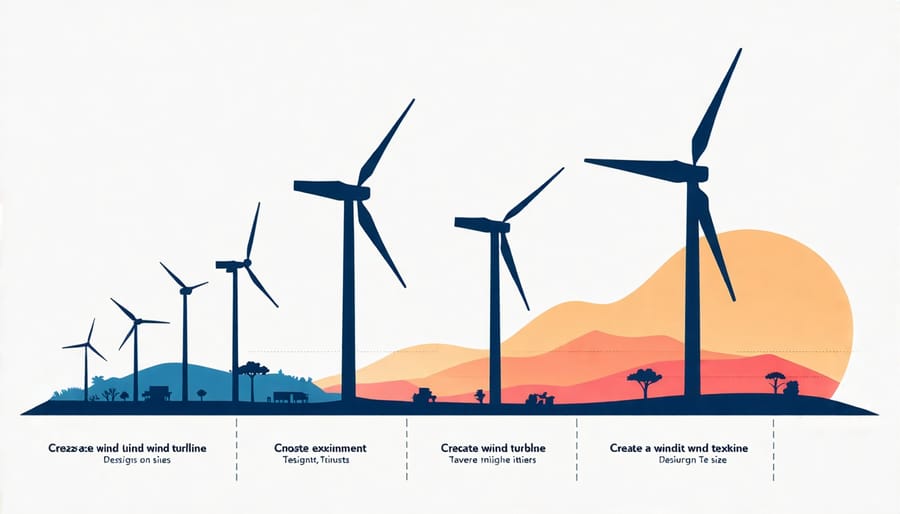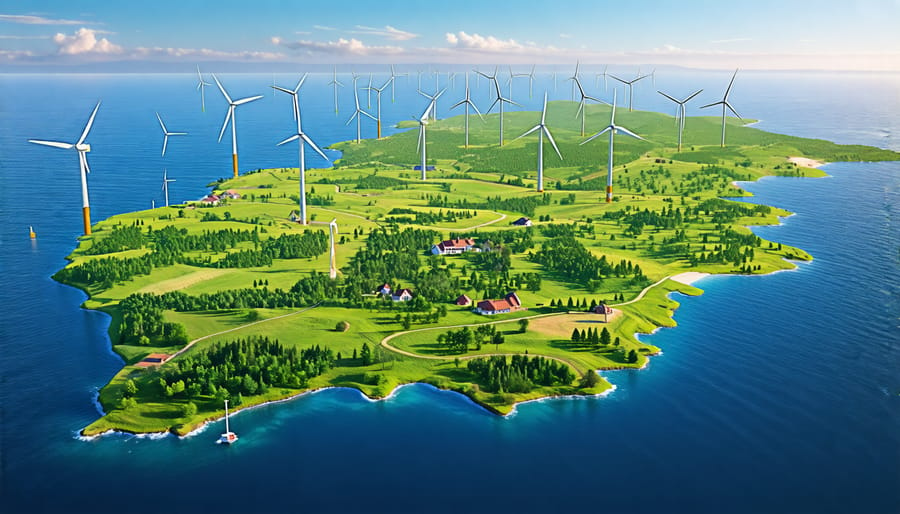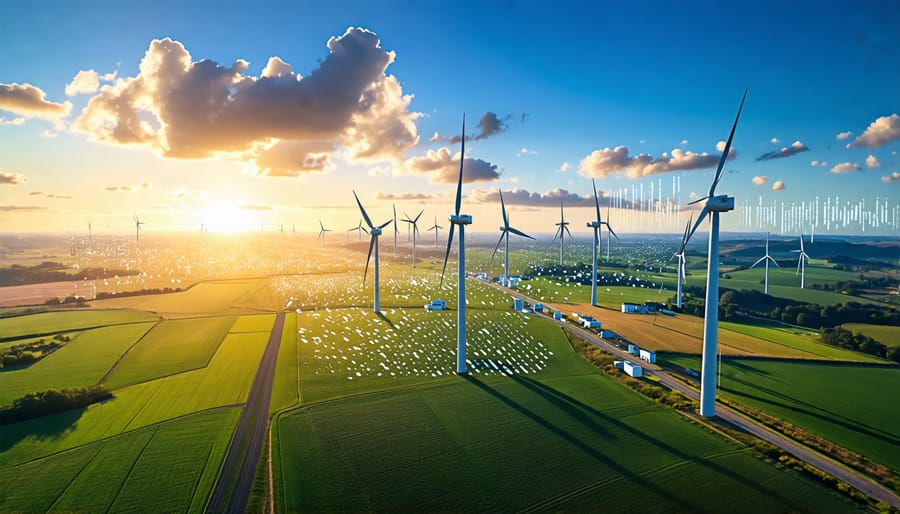Harnessing the power of wind, sprawling turbine arrays dot landscapes worldwide, converting nature’s breath into clean, renewable energy. But what determines the average output of these modern marvels? Join us as we explore the fascinating world of wind farm performance, delving into the intricate dance of technology, terrain, and atmospheric conditions that shape the electricity flowing from these towering giants. Discover the cutting-edge advancements propelling wind energy to new heights and the critical role it plays in our transition to a sustainable future. Get ready to unravel the mysteries of average wind farm output and gain a deeper appreciation for the incredible potential of this rapidly growing industry.
Factors Influencing Wind Farm Output

Wind Speed and Consistency
Wind speed and its consistency play a crucial role in determining the energy generation of a wind farm. Higher wind speeds generally result in increased power output, as wind turbines can capture more kinetic energy from the moving air. However, wind turbines are designed to operate within a specific range of wind speeds, typically between 3 and 25 meters per second (m/s). If the wind speed is too low, the turbines may not generate any power, while excessively high winds can cause the turbines to shut down to prevent damage.
The variability of wind speed also affects the consistency of energy output. Locations with steady, reliable winds are ideal for wind farms, as they can provide a more predictable and stable energy supply. In contrast, areas with highly variable wind speeds may experience significant fluctuations in energy generation, making it more challenging to integrate wind power into the grid. To mitigate these issues, wind farm developers conduct extensive site assessments to identify locations with optimal wind resources and use advanced forecasting techniques to predict wind patterns and adjust energy production accordingly. By understanding the relationship between wind speed, consistency, and energy generation, wind farm operators can optimize their facilities’ performance and contribute to a more sustainable energy future.

Wind Turbine Technology
Wind turbine technology plays a crucial role in optimizing the average output of wind farms. Advancements in turbine design, such as longer blades and taller towers, allow for capturing more wind energy at higher altitudes where winds are stronger and more consistent. Larger turbines, with capacities exceeding 5 MW, are becoming increasingly common, enabling wind farms to generate more electricity from fewer units. Moreover, improvements in blade aerodynamics and materials enhance efficiency by maximizing lift and minimizing drag.
The introduction of smart control systems and sensors further optimizes turbine performance by constantly monitoring wind conditions and adjusting blade pitch and yaw to maintain optimal angles for maximum energy capture. These technologies also help reduce mechanical stress on components, increasing reliability and minimizing downtime. As turbine technology continues to evolve, with innovations like offshore floating platforms and airborne wind systems on the horizon, the potential for higher average output from wind farms grows, making wind energy an increasingly attractive and viable solution for meeting our renewable energy goals.
Geographical Location and Terrain
The geographical location and terrain of a wind farm play a crucial role in determining its average output. Wind speed and consistency are heavily influenced by factors such as elevation, proximity to large bodies of water, and the surrounding landscape. Sites located on higher ground, such as hilltops or ridges, often experience stronger and more consistent winds compared to lower-lying areas. Similarly, wind farms situated near coastlines or in open plains benefit from unobstructed wind flow, resulting in higher output.
The terrain surrounding a wind farm can also impact its performance. Rough terrain, such as forests or urban areas, creates turbulence and reduces wind speed, leading to lower energy production. On the other hand, smooth, unobstructed landscapes allow wind to flow freely, maximizing the potential output of wind turbines.
When selecting a site for a wind farm, developers must carefully consider these geographical factors to ensure optimal performance. Advanced modeling techniques and wind resource assessments help identify the most suitable locations, taking into account not only wind speed and consistency but also the potential impact of the surrounding terrain on turbine efficiency.
Real-world examples demonstrate the significance of site selection. The Alta Wind Energy Center in California, one of the largest wind farms in the world, benefits from its location in the Tehachapi Pass, known for its strong and reliable winds. Similarly, the Roscoe Wind Farm in Texas, situated on the high plains, takes advantage of the region’s vast open spaces and consistent wind patterns to achieve impressive output levels.
As the wind energy industry continues to grow, identifying and developing sites with optimal geographical and terrain characteristics will be crucial in maximizing the average output of wind farms and contributing to a sustainable energy future.
Calculating Average Wind Farm Output
Capacity Factor: The Key Metric
Capacity factor is a critical metric for evaluating the performance and efficiency of wind farms. It represents the ratio of actual energy output over a given period to the maximum possible output if the wind farm operated at full capacity continuously. A higher capacity factor indicates that a wind farm is generating electricity more efficiently and consistently.
Several factors influence a wind farm’s capacity factor, including wind speed, turbine design, and site selection. Wind speed is the most significant determinant, as wind power is proportional to the cube of wind speed. Consistent, strong winds lead to higher capacity factors. Turbine design also plays a role, with larger, more advanced turbines generally achieving higher capacity factors due to improved efficiency and ability to capture more wind energy.
Capacity factors for wind farms typically range from 20% to 40%, with some high-performing sites reaching up to 50%. While these figures may seem low compared to conventional power plants, it’s important to note that wind energy is a renewable resource with no fuel costs. Optimizing capacity factors through careful site selection, advanced turbine technology, and efficient operations can significantly improve the average output and economic viability of wind farms.
Real-World Examples and Case Studies
One of the most notable wind farms in the United States is the Alta Wind Energy Center in California, which boasts an impressive capacity of 1,548 MW and an average annual output of around 3,000 GWh. In Europe, the London Array offshore wind farm in the United Kingdom has a capacity of 630 MW and generates an average of 2,500 GWh per year, enough to power over half a million homes.
China’s Gansu Wind Farm, one of the largest onshore wind farms globally, has a staggering capacity of 8,000 MW and an estimated average output of 20,000 GWh annually. These real-world examples demonstrate the significant potential of wind energy in various regions worldwide.
Case studies from different countries also highlight the factors influencing wind farm output. For instance, Denmark’s Horns Rev 3 offshore wind farm, with a capacity of 407 MW, benefits from strong and consistent winds in the North Sea, resulting in an impressive capacity factor of nearly 50%. In contrast, some wind farms in less windy locations may have lower capacity factors, emphasizing the importance of site selection and wind resource assessment in maximizing output.

Optimizing Wind Farm Performance
Advancements in Wind Turbine Design
Wind turbine design has seen significant advancements in recent years, thanks to the development of cutting-edge technologies that enhance efficiency and output. One notable advancement is the use of longer and lighter blades, which allow turbines to capture more wind energy at higher altitudes. These blades are often made of advanced composite materials, such as carbon fiber, that provide excellent strength-to-weight ratios. Another innovation is the implementation of smart control systems that can adjust the pitch and yaw of the blades in real-time, optimizing their position to maximize energy capture and minimize stress on the turbine components. Additionally, the integration of advanced sensors and data analytics enables predictive maintenance, reducing downtime and increasing overall wind farm efficiency. As these technologies continue to evolve, wind turbines are becoming more reliable, cost-effective, and capable of generating higher outputs, contributing to the growth of wind energy as a sustainable power source.
Smart Grid Integration and Energy Storage
To maximize the potential of wind farms, modernizing electrical grids and implementing energy storage solutions are crucial. Smart grid technology allows for real-time monitoring and control of wind farm output, optimizing performance and reducing energy waste. By integrating advanced sensors, communication systems, and data analytics, grid operators can better manage the variable nature of wind power and ensure a stable, reliable energy supply.
Energy storage is another key component in optimizing wind farm output. During periods of high wind, excess energy can be stored in batteries, flywheels, or pumped hydro storage systems for later use when demand is high or wind speeds are low. This not only improves the overall efficiency of wind farms but also helps to balance the grid and reduce reliance on fossil fuel-based backup power.
Innovative storage solutions, such as compressed air energy storage (CAES) and hydrogen storage, are being developed to further enhance the integration of wind power into the grid. These technologies have the potential to store large amounts of energy for extended periods, making wind power an even more viable and flexible energy source for the future. By investing in smart grid infrastructure and energy storage, we can unlock the full potential of wind farms and accelerate the transition to a clean, sustainable energy system.
Conclusion: The Future of Wind Energy
In conclusion, wind energy has made remarkable strides in recent years, with advancements in technology and increased global adoption contributing to higher average wind farm outputs. As the world continues to shift towards renewable energy sources, the future of wind energy looks promising. Governments and organizations are setting ambitious targets for wind power generation, and ongoing research and development efforts aim to further improve turbine efficiency and performance.
The potential for wind energy to play a significant role in mitigating climate change and reducing our reliance on fossil fuels is immense. As more countries invest in wind power and integrate it into their energy mix, we can expect to see a surge in the number of wind farms and their overall output. This growth will not only contribute to a cleaner environment but also create jobs and stimulate economic development in communities around the world.
While challenges such as intermittency and storage remain, the wind energy industry is working tirelessly to develop innovative solutions. With continued support from policymakers, investors, and the public, wind power has the potential to become a cornerstone of our global energy landscape, paving the way for a more sustainable and prosperous future.





